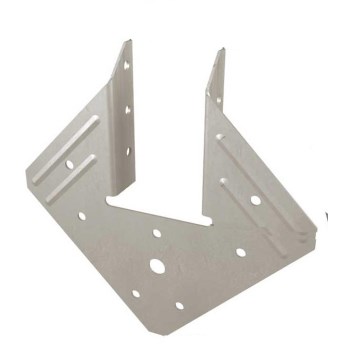

To find the number of fasteners per connection, divide tie force by 100 pounds per nail (typical capacity of a 16d nail). It’s easy to underestimate the number of fasteners needed for each rafter-to-rafter-tie connection (and at any center splice in this assembly). Compare this with a similarly framed 12/12 roof that has similar loads: The tie force at the plate is 480 pounds - and only 720 pounds when the ties are 4 feet up from the plate (again, the maximum allowed by code). Moving the rafter ties up only 16 inches from the plate (the maximum allowed by code) increases the tie force from 1,440 pounds to 2,160 pounds. In this example, when W = 960, the tie-force tension at the plate when there are rafters 24 inches on-center with a 4/12 pitch and a 12-foot span is 1,440 pounds. Here’s a formula I use to determine tie force: T = W/2 x H/h x run/rise, where W equals rafter load, H equals height of ridge, and h equals distance from ridge to center of tie (illustration, below).

And when rafter ties are used above the plate, the rafter span must be reduced by as much as 33 percent compared with the span allowed when the ties are at the plate. If your garage is 24 feet wide and has a 4/12 roof, the new rafter ties can be placed no more than 16 inches up from the plate without additional engineering.įrom a practical perspective, it’s difficult to use high rafter ties on a low-pitched roof because the force in each tie increases with the inverse of the pitch. Previous building codes permitted rafter ties to be placed as high above the plate as two-thirds the distance between the top plate and the ridge, but the 2006 IRC now limits this height to one-third the distance between the plate and the ridge (see Footnote A, Table R802.5.1, 2006 IRC). To resist thrust, the IRC calls for a structural ridge (required for any roof with a pitch less than 3/12) or for each pair of rafters to be securely connected to each other by a continuous ceiling joist (R802.3, 2006 IRC).Ĭode does allow joists to be installed above the top plate, but only under certain conditions. This horizontal load - or thrust - can be considerable, especially on a low-pitched roof. Jordan Truesdell, a structural engineer in Blacksburg, Va., responds: In a simple gable roof, the rafters carry live and dead loads that push both down and out against the top of the supporting walls. As a compromise, can I replace the existing ceiling joists with rafter ties?Ī. They like the idea of a vaulted ceiling but not the expense of the new structural ridge it would require. My clients have a garage with a conventionally framed 4/12 roof that they want to convert to living space. Held fine until we tore it off for a second story addition.Q. I jacked up the roof over a couple weeks, nailed the out of the rafter/rafter tie lap, and created a truss system with plywood gussets. I talked to my engineer and learned that the connection of the rafter ties to the rafters where they lap was very important. That wasn't enough and over time that nailed joint began to fail and the ridge sagged, the walls moved and the fascia bowed under the stress. They were probably enough to keep the rafters in place, the ridge board from sagging and the walls from splaying outward but the framer only used a couple or 3 16d's at the lap with the rafters. My current house had a concrete tile roof with 2 x 6 rafter ties every 4 ft.

Always use the metal straps over the ridge. I've installed engineer designed collar ties with no rafter ties or ceiling joists but they were engineered carefully and installed properly.

They might also reduce the deflection on very steeply pitched and undersized rafters in an existing structure. The author neglects to consider the main purpose of the ties, which is to keep the rafter tops spreading during wind uplift, but this is done much more cheaply through metal straps.


 0 kommentar(er)
0 kommentar(er)
